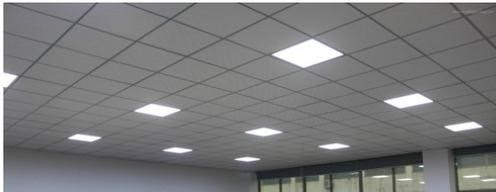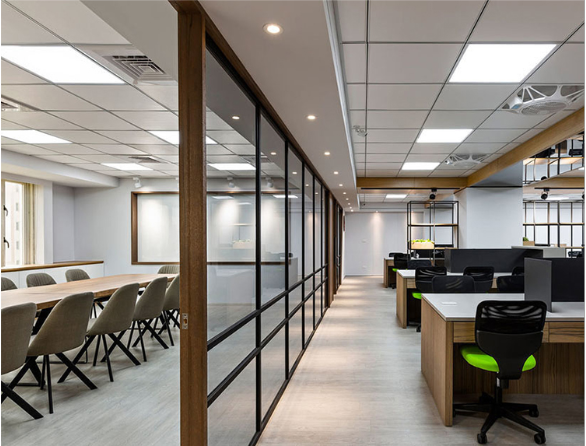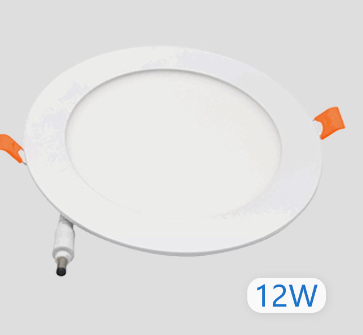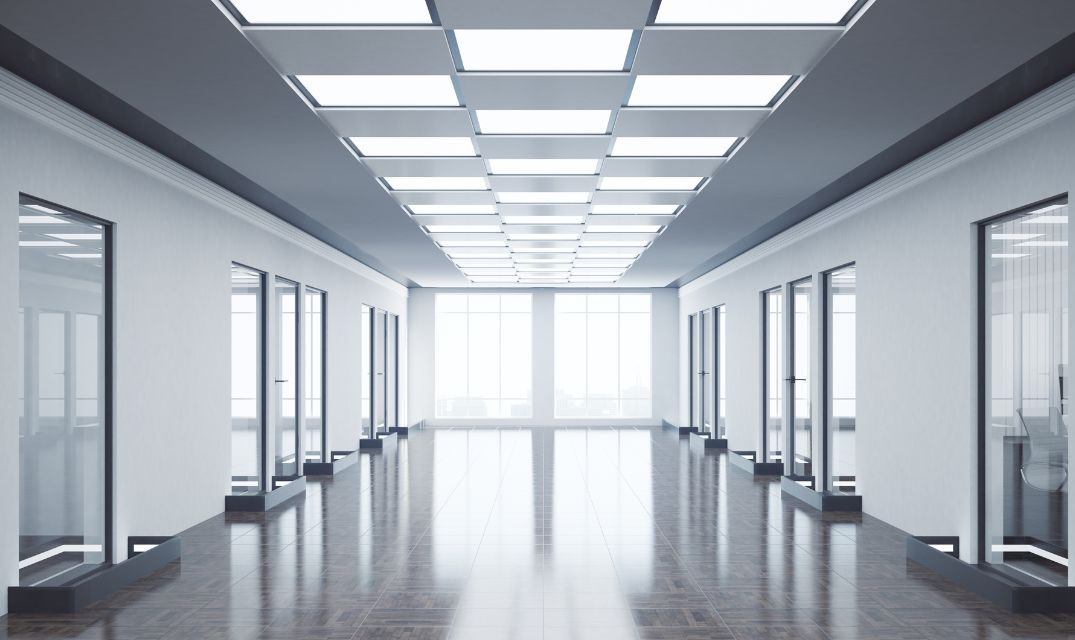A reversal of design aesthetics: When light learns to become invisible.
Stepping into the new headquarters of a Shenzhen internet company, designer Chen Lang stood in the lobby with eight-meter-high ceilings and pointed to the ceiling: "Look, light is everywhere, but there's not a single light." He was referring to the array of LED panel lights embedded in the ceiling like a star. These flat light sources, less than two centimeters thick and boasting a luminous area of several square meters, are rapidly replacing traditional grille lights and becoming the dominant force in modern space lighting.
This isn't an isolated case. From Alibaba's Xixi campus to Beijing Daxing Airport, from the MUJI flagship store to the operating rooms of tertiary hospitals, LED panel lights, with their minimalist appearance, uniform light, and spatial integration, have quietly conquered the commercial lighting market. More notably, this trend is now making its way into the home. On Xiaohongshu, the topic "no main light design" has garnered over 320 million views, with "ultra-thin recessed panel lights" becoming the key tool for achieving a high-end, flat-ceiling design. Designer Wang Wei admits, "Customers are now most afraid of not even noticing the 'existence' of the lighting fixture. Panel lights make ceilings appear to have their own pure glow."
Market data confirms the breadth of this transformation. According to the latest 2024 report from the Gaogong Industry Research Institute (GGII), China's LED panel light market has exceeded 45 billion yuan, with a compound annual growth rate of 18.7%, far exceeding the growth rate of general lighting products. Its penetration rate in the office sector is as high as 85%, in the education and healthcare sector over 70%, and in the home sector, it has soared from less than 5% five years ago to 32%, making it the market segment with the greatest potential for explosive growth.

Technological Iteration: The Underlying Evolution from "Lighting" to "Intelligent Transformation"
The explosive growth of LED panel lights is the result of a technological journey spanning over a decade. Early panel lights were criticized for poor light uniformity, dark areas, and yellow edges. Today, technological breakthroughs have completely rewritten the product's DNA:
Optical system revolution: The golden combination of microprismatic light guides and diffuser films achieves light uniformity exceeding 95%, completely eliminating visual mottle. Flagship products from industry leaders like NVC and OPPLE even achieve "paper-level" uniformity.
Ultra-thinness: From its early 40mm thickness to the current 8mm, panel lights seamlessly blend into plaster ceilings. A Sanxiong Aurora R&D leader revealed, "This is thanks to the application of high-density surface-mounted devices (SMD) and flip-chip technology, which enable higher light efficiency in a smaller space."
Material science breakthrough: The aircraft-grade aluminum frame reduces weight by 30% and improves thermal conductivity by 50%. A nano-scale anti-glare coating reduces the Unified Glare Ratio (UGR) to below 16, far exceeding the national standard limit of 19 and meeting operating room-grade eye protection standards.
A more critical leap forward lies in the "deep integration of light and intelligence." Panel lights, with their compact structure and ease of integration, are naturally the best vehicle for smart lighting. In Huawei's whole-home smart solution, panel lights serve as core nodes, leveraging sensors to automatically adjust brightness and color temperature. Tuya Smart's mesh-networked panel lights achieve 0.1-second touchless dimming. Zhang Peng, CTO of NVC Lighting, asserted, "In the next three years, panel lights without intelligent capabilities will be eliminated from the market."

Healthy Light Environment: The Value Transformation from "Functional Need" to "Healthy Necessity"
As the connection between light environment and human health is scientifically validated, the value proposition of panel lights has undergone a fundamental shift. Traditional lighting focuses on "illumination," while modern panel lights are evolving into "customizers of healthy light environments."
Full-spectrum lighting is becoming increasingly common: With the cost of violet light-excited chips dropping by 30%, high-end panel lights are now widely equipped with sunlight-like full-spectrum technology. Authoritative testing shows that high-quality panel lights generally have a color rendering index (Ra) greater than 97 and an R9 (saturated red light) greater than 95, far exceeding those of ordinary lamps. Using these lamps in classrooms has reduced student visual fatigue by 37%, according to data from the China Academy of Building Research.
Rhythmic lighting is being implemented: Adjustable color temperature panel lights (2700K-6500K) are widely used in office spaces. After a Shenzhen technology company deployed an intelligent circadian system, afternoon fatigue among employees decreased by 41%. Hospital wards significantly improve patients' sleep quality by simulating changes in natural light.
Biosafety upgrades: Flicker-free (flicker ratio <1%) and low blue light hazard (RG0 level) are now standard features in mid-to-high-end products. The national mandatory standard "Performance Requirements for Reading and Writing Desk Lamps" has incorporated relevant indicators, and policy support is accelerating the trend towards health.

"Health is no longer a plus point, but a bottom line requirement," emphasized Dou Linping, Secretary-General of the China Illuminating Engineering Society. Authoritative certifications have become market credentials: Products certified by CQC Healthy Lighting and Germany's TÜV Eye Comfort (eye comfort) command premiums of up to 25%-40%, demonstrating consumers' willingness to pay for health.
Transforming Scenarios: Infinite Possibilities from Offices to Global Spaces
The panel lighting market has long transcended traditional boundaries, expanding into multi-dimensional scenarios:
High-end Homes: Ultra-thin, borderless, embedded panel lights have become a standard feature in luxury homes, blending seamlessly with artistic paint and microcement ceilings. Linear tiled panel lights create a "skyline lighting effect" in living rooms, replacing traditional chandeliers.
New Retail Spaces: Clothing stores use high-color rendering panel lights (Ra ≥ 98) to restore the true colors of fabrics; fresh food supermarkets use red spectrum-enhanced panels to enhance the appeal of meat, resulting in a 15% sales increase (Opple Lighting case data).
Medical Purification: Corrosion-resistant stainless steel panel lights are used in operating rooms to meet sterile environment requirements; diffusers are coated with antimicrobial coatings to inhibit the growth of pathogens.
Outdoor Revolution: Waterproof panel lights (IP65 rating) transcend indoor limitations and are now used in bus stop ceilings and corridor ceilings, achieving integrated architectural floodlighting.
Customization is becoming the key to breaking through the competitive landscape. Foshan Lighting's custom-made marble-patterned panel lights for five-star hotels are five times more expensive than conventional products, yet demand remains insufficient. Xidun Lighting has introduced custom-shaped panel lights, including round and triangular ones, to meet the personalized needs of designers. The fragmentation of application scenarios is driving continuous product innovation.

Hidden Reefs and Blue Oceans: The Battle for Innovation amidst Price Wars
Amidst the market's rapid growth, hidden concerns have emerged:
Low-end Overcapacity: Panel light capacity utilization will only be 65% in 2023, plunging small and medium-sized manufacturers into a fierce price war. The price of a basic 60x60cm panel light on one e-commerce platform has fallen below 20 yuan, exacerbating the risk of quality issues.
The Dilemma of Homogeneity: 80% of products focus on basic office lighting, offering highly similar functions and lacking innovation.
Standardization Lag: Current national standards lack constraints on new features such as smart connectivity and spectral quality, leading to the phenomenon of bad money driving out good.
The path to breakthrough clearly emerges from two dimensions:
Technology: Leading companies are betting on Mini LED backlight panel lights, achieving 1,000-level zone dimming and a hundredfold increase in contrast. Panel lights specifically designed for plant lighting (including specific red and blue spectrums) are being used in vertical farms, achieving profit margins exceeding 40%.
Service Value Chain: Sanxiong Aurora launched a "Light Health Diagnosis" service, providing customized solutions based on spatial functions. NVC established a cloud-based light environment database to enable AI-powered optimization of lighting solutions. Service premiums are becoming a new profit engine.
"The future belongs to 'light solution providers,' not lighting manufacturers," asserted Lin Yandan, professor of the Department of Light Sources and Illumination Engineering at Fudan University. According to Boston Consulting Group, by 2028, the market size of China's smart and healthy lighting solutions will exceed 100 billion yuan, with panel lights occupying a core position as the foundational carrier.
The Future Has Arrived: When Light Becomes the "Breath" of Space
Standing in the Huawei Hongmeng Intelligent Connected Zone at the Shanghai International Lighting Exhibition, an engineer tapped their phone: a transparent OLED panel light embedded in a conference table gradually illuminated, instantly transforming the surface into a writable display, with the light's color temperature automatically adjusting as the meeting progressed. This wasn't just a concept demonstration—these panel lights, which combine display and lighting, are already entering the countdown to mass production.
The future is being mapped out in the lab:
Perovskite quantum dot technology promises to boost panel light efficiency beyond 200 lumens/watt, reducing energy consumption by another 40%;
Self-healing flexible panel lights can bend and conform to curved surfaces, completely breaking the limitations of flat surfaces;
LiFi (Li-Fi) optical communication technology allows panel lights to simultaneously transmit gigabit-level data while providing illumination...
Conclusion:
The evolution of LED panel lights mirrors the evolution of human understanding of light: from a tool to dispel darkness, to a brush to shape space, and ultimately, to a nourishing energy field. When a thin, cicada-wing-thin light panel can simulate the morning glow of the Alps, the dusk of the Mediterranean, and even instill the growth code for plants, we will finally understand: the ultimate goal of the lighting revolution is not to create brighter lamps, but to create light that better understands human nature. In this silent revolution of light, Made in China is transforming from a technology follower to a standard setter. This beam of light that penetrates the ceiling from the laboratory illuminates not only space, but also an industry's journey to the top of the global value chain.



